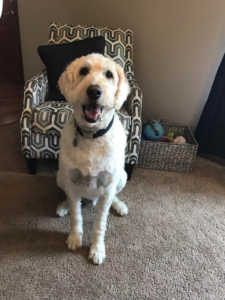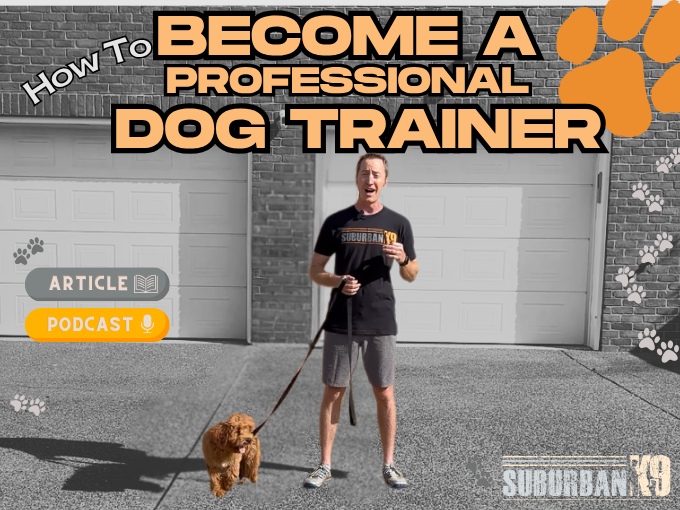Have you heard of proofing dog obedience training commands?
Anyone out there that has baked bread has heard of proofing your dough. It is the final step of allowing the shaped dough to rise before baking. Proofing is also a term that is used in dog training and much like in baking, proofing is one of the final steps before completing your training process. Proofing your dog’s behavior is simply a fancy way of saying that you are teaching your dog to perform a certain command (or act in a certain way) regardless of the situation. In my experience many dog owners do a great job of teaching their dog a command, but do not spend enough time on the final training step of proofing obedience commands. All dog owners have goals in mind for their pet, even if they don’t think of them as training goals. A great example is when an owner asks a dog to come in from outside. What the owner does not realize is that there are many distractions for the dog outside and if they have not proofed the come command around distractions it is unlikely that the dog will perform the command, even if they already know what come means. If you would like help getting your dog proofed on their commands, check out our In-Home training or our Board and Train Programs
After teaching your dog the come command it would be easy to put on a show and impress your friends and family with how great he is doing. Simply take your dog to the place where you taught him the come command eliminate all the distractions and show off his skills at coming when called. But what happens if you take the dog to your friend’s house to show off his new command? There is a very real chance that your dog will either stare at you blankly or be too distracted by all the exciting things around him in order to properly listen to his command. This is why we must proof the command!
How Proofing Obedience Works
It is much easier to understand how proofing works if you think about it in the context of one command at a time. In this article we will focus on the come command. The first step in training your dog to come when called is to teach your dog what come means. At Suburban K9 we generally train dogs to run to us and sit facing us when they hear the come command. This means that we teach and master the sit command before teaching come. When we begin teaching the dog how to come when called we start in a very calm environment without distractions. We teach inside without a lot of other dogs or people around so that the dog can focus his entire brain on the task at hand. This process can take anywhere from a few minutes to a few days depending on the dog. It is important to ensure that the dog fully understands the command before moving on.
Build a Bond Through Proofing
Training your dog to be obedient is an important part of building a strong bond and relationship. It’s also not a lot of fun to live with an untrained dog. When your dog listens to every command in every situation you can take them with you everywhere and have a great life together! Ask for a price quote today for us to help you make sure you live a happy life with your trained and proofed pup!
Why is Proofing Obedience important?
Proofing your dog's obedience commands is essential to ensure that they respond consistently, regardless of the environment or distractions. Dogs are contextual creatures, and they respond to the stimuli around them. As a result, it's important to train them in various environments and scenarios to help them become well-rounded and reliable. With our In-Home training and Board and Train programs we make sure to train dogs any place where the owner wants them to listen.
Using a balanced training approach
A balanced training approach involves a combination of positive reinforcement and correction-based training methods. It's important to note that this approach doesn't rely solely on punishment or negative reinforcement, but instead uses correction-based training in conjunction with positive reinforcement.
The following tips will help you proof your dog's obedience commands using a balanced training approach:
Start with Basic Obedience Training
Begin with basic obedience training in a controlled environment with minimal distractions. Teach your dog commands such as sit, stay, come, heel, and down. Use positive reinforcement, such as treats and praise, to reward good behavior. Once your dog has mastered the commands, gradually increase the level of difficulty by introducing distractions.
Gradually Increase the Level of Distractions
When proofing your dog's obedience commands, start with low-level distractions and gradually increase the level of difficulty. For example, practice in a quiet park with few distractions and gradually move to a more crowded park with more distractions. Use positive reinforcement to reward good behavior and correction-based training to address unwanted behavior.
Use Positive Reinforcement
Positive reinforcement can be a powerful tool in training your dog. Use praise to reward good behavior. This will encourage your dog to repeat the desired behavior in the future.
Correct Unwanted Behavior
Correction-based training involves addressing unwanted behavior through verbal correction, body language, or physical correction. For example, if your dog breaks a stay command, use a verbal correction such as "no" and then guide them back into the correct position.
Practice in Different Environments
It's essential to practice your dog's obedience commands in various environments to help them become well-rounded and reliable. Practice in different parks, neighborhoods, and environments with varying levels of distractions. Use positive reinforcement and correction-based training to help your dog respond consistently in different scenarios.
Be Patient and Consistent
Training your dog to respond to commands consistently takes time and patience. Proofing the come command can seem daunting at first, but it is much easier when you consider it a series of small manageable exercises rather than one large task. Create a list of locations where you want your dog to listen and common distractions you want him to be able to ignore when needed. When making the list don’t forget the obvious; your front and back yard, different rooms of the house, and your garage. You should also include some more difficult places the dog might encounter; your parents’ house, a grassy field, a store parking lot, and around your neighborhood. In terms of distractions you’ll probably want him to listen when he sees another dog, a cat, a squirrel, an adult, a child, a person on a bike, food, toys etc. Use your balanced training approach and keep working until your dog does great every place you go!
Conclusion
Just as proofing is an essential part of baking, proofing is also essential in order to have a fully trained dog. Even if you don’t plan on ever letting your dog off leash in a non-fenced area, he will probably get loose at some point in time. A dog who has had his come command proofed is much less likely to run off and get lost or hurt. It would take a full book to cover all the additional questions that may arise after reading this article, but hopefully this is enough to get you excited and point you in the right direction. Proofing your dog's obedience commands is an essential part of training your furry companion. Using a balanced training approach that combines positive reinforcement and correction-based training methods can help your dog become well-rounded, reliable, and obedient. Start with basic obedience training, gradually increase the level of distractions, use positive reinforcement, correct unwanted behavior, practice in different environments, and be patient and consistent. With these tips, you can help your dog become a well-trained and obedient companion.





